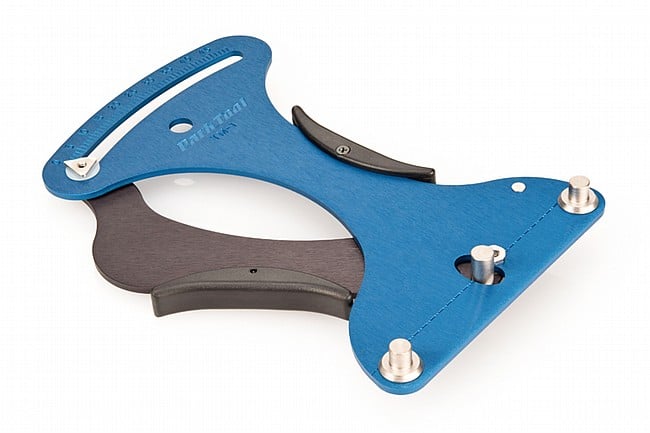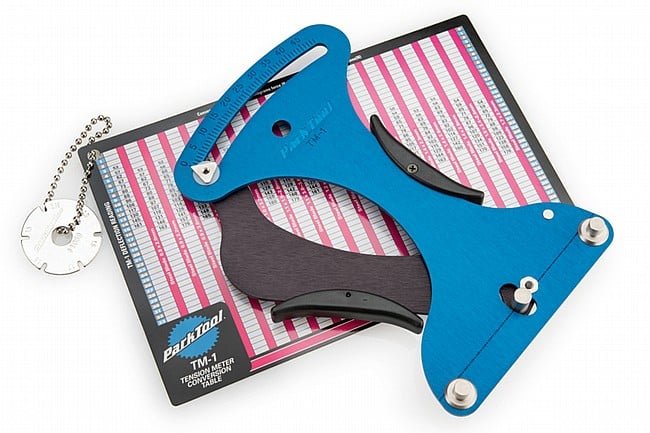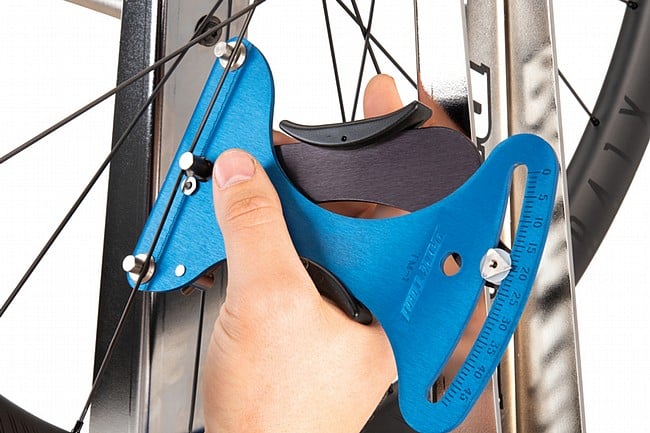Crumbs
Product Images




Description
Perfect Spoke Tension Every Time
The Park Tool TM-1 Spoke Tension Meter accurately and reliably measures the absolute tension of each of the spokes in a wheel, as well as the relative tension between all the spokes in a wheel. Easy to use and priced affordably, the TM-1 works on nearly any bicycle spoke—no matter what the diameter, material, or shape. The TM-1 is for anyone building or truing wheels, diagnosing wheel problems, or assembling new bikes. It's a tool that belongs on every workbench.
Features:
- Accurately measures absolute and relative spoke tension
- Compatible with all bicycle spokes regardless of material or shape
- TM-1 includes a printed table to convert tension readings to kilograms force
B-Stock - This product has one or more B-Stock units available. These units can be purchased at a discount (see option select). B-Stock units were returned from other customers and may have missing or damaged packaging materials. These units are otherwise as new. The full manufacturer warranty applies. Click Here for more information.
The product weight specified is an approximate weight based on the manufacturer's specifications (if available) or our measurement of one or two examples. For most products, the weight will typically vary by 5% to 10%.
Specifications
Weight: 300 grams | |
Mfg PartNum: TM-1 | |
Tool Type: Wheel Tools | |
Reviews
I had a carbon rim that needed help. I didnt want to just jump into it without knowing how tight spokes were getting. Glad I have this as Im sure I would have really messed it all up. This simple tool shows you the tension on each spoke. I couldnt imagine truing a wheel without it now. This tool allowed me to back all the spokes off then get the egg out, then go after true. All the wile checking tension and then bringing the spokes up to tension you can really get them all even tension. Easy to use, just take your time.
New wheels, whether machine or hand trued, may arrive with incorrect spoke tensions which can lead to unhappiness. Checking before use is good, and this also takes some of the mystery out of replacing broken spokes on old wheels. Even if you only have one (but why stop there?) set of wheels to maintain, this can still tell you valuable info.
If you are going to true your wheels to get the wobble out then you should also check tension as well. I learned that tension is vital to wheel health. This tension meter works well. Takes a little getting used to on how fast you should release the handle to get the reading but you figure it out after your first wheel. This works hand in hand with Park Tools web page for gathering your measurements. Great resource as well.
I would buy it again as it is pretty indispensable.
The gauge is spendy but worth it. I used to build wheels and true them by feel. But now that I have this gauge I won't go back. My new approach to an existing wheel is to run through the wheel and get an average reading before I do any truing, then go back through and use small bits of tape to ID spokes that fall way outside the norm.... low tension get tagged down at the hub, high tension get tagged out by the rim. Then when you start working out the issues it becomes really obvious what you need to do.
For new wheels get 90% of the tension on the spokes, set the spoke heads in the hub whatever way you normally do it (hammer, flexing pairs, stepping on the wheel!) then go through and even out all the tensions before doing the last 10%. It will speed things up a lot and you end up with a much stabler finished product.
My only word of caution is to always measure the spokes the same distance from the rim, and release the gauge slowly and smoothly. There is friction in the gauge and if you pop the handle open you will get readings that do not repeat because things are too dynamic.... just be gentle and consistent and the readings will repeat accurately.
I had been using a friends tension meter and didn't understand how to use it properly. At the risk of using my manhood card, I read the instruction and discovered that my wheels where in better tune that previously believed. The meter comes with a spoke gauge and convertion meter to tension chart which are estential. So is the release motion.
I bought the TM-1 tension meter to assist in building up a pair of wood rimmed wheels for a retro bike project. The tool was invaluable in assuring that tensions were uniform and as a result the wheels have been solid. This project used steel butted DT spokes. I also used the tool on a Mavic Cosmic Ultimate tubular rear wheel to bring the wheel back into true w even tensions on the flat bladed spokes - again worked like a charm. Wish I'd had something like this when I was building lots of wheels back in the '70s and '80s - its simple to use and cheap compared to what else is out there to do the same thing.
This updated version seems better made and more repeatable than the old one. It takes some technique (fiddling and repeated application) to get confidence you have the best number. Watch carefully how and where the spoke sits against the pins - it makes a difference (lower) in the number. Park doesn't tell you this in detail, but you have to find the position on the spoke that maximizes the deflection (minimizes the measured tension force). That position has the gauge movable pin nearest to the center of the spoke (or the midpoint between the butted sections) as you can tell by eye. Don't bother measuring the spoke and marking the midpoint. The accuracy of the this instrument and the effect on the result does not justify that much fuss. Just do it consistently from spoke to spoke. The goal is to even out the tensions on each side. Do read all the advice online from Park (and other places) and use the Park WTA. Their conversion calculation for spoke tension online is slightly different than the provided chart.
I have been building wheels for 25 years without the Park TM-1. I have built and re-built wheels for my two road bikes, and have built probably 20 wheels. I have never built a rear wheel that hasn't required re-truing after two or three rides, until using the Park TM-1 tool. I wish I had purchased this tool 25 years ago! I rebuilt the rear wheel for my road bike and tensioned the spokes according to the tension chart provided with the tool. I have not needed to re-true the wheel at all since checking and balancing the tension in the spokes - and that was two months and more than a dozen rides ago!
Mechanic's Corner
Articles will open in new tab.























